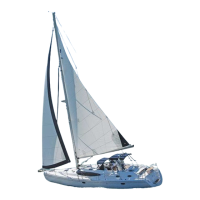nt
r
• Gettin
Underwa
1
.
WARNING
! !
In order to prevent premature starter failure, do not
ontinuousl
crank en
ine starters for more than 10
seconds
.
s t
e en
nes warm, t
e temp
au
e w
start to r
se.
Watch the
au
e and make sure that the en
ines do not
r
n h
t
.
nce the en
ines come up to operatin
temp
check
manu
acturer’s recommendations
or correct tempera-
ture
, move the shift lever to Fwd and Reverse to make
sure that the transmission will en
a
e.
7.
ow, s
ut
own t
e en
nes an
rec
ec
our o
an
tr
n
mi
i
n
l
i
l
v
l
.
WARNING
! !
O NOT remove coolin
s
stem filter cap when en-
ne
s
ot.
ow to coo
an
t
en remove pressure
ap slowl
, allowin
pressure to vent. Hot coolant
nder pressure ma
dischar
e violentl
WARNING
! !
xhaust
asses contain Carbon Monoxide. This is
a poisonous
as and can cause death. Shut down
en
ines immediatel
, if an
exhaust leaks are de-
tected
Important: Always be careful when starting the engines. Use
common sense and good judgment. Shut down the engines
immediately if you observe any unsafe operating conditions.
Important: If engine fails to start within 10 seconds, release
switch. Allow starter motor to cool for at least 60 seconds, then
try starting the engine again.
Note: Should there be a problem with the battery voltage level,
see the section in this chapter for emergency operation.
13.3 Gettin
Underwa
WARNING
! !
efore ever pullin
awa
from the dock, make sure
hat the shore power cord and the fresh water hoses
re disconnected.
heck that the
resh water tanks are
ull.
erif
that
ou have up to date fire extin
uisher and
l
r
ake sure
ou have the required safet
equipment for
u
.
After en
ines reach operatin
temperature, accelerate
the en
ines to 2000 RPM’s.
heck that voltmeters read
1
t
14.
v
lt
.
heck wind, tide, and current to determine the best wa
to maneuver
our boat awa
from the dock. Cast of
moor
n
nes
hift
our boat’s en
ine into forward or reverse, depend-
n
on w
et
er
ou want to move t
e
ow or t
e stern
awa
rom the dock
irst. Your en
ines should be runnin
at a slow speed as
ou move awa
rom the dock
nce
our boat is in open water,
ou can sa
el
acceler-
ate to cruisin
speed. Advance throttle to settin
which
provides
our desired en
ine speed
RPM’s
.
3.3.1 Gettin
Read
to Sai
Note: This is not intended to provide a complete guide on sail-
ing! The ‘art’ of managing a sailboat in all weather, tidal and
day/night conditions can not even be taught by reading even the
best instruction book. If you are not proficient in handling sail
boats please refrain from handling this boat and obtain profes-
sional training and certificates of which some might be required
for you to navigate this boat in certain areas or countries.
he followin
is a simple
uide onl
:
1. In
t
ll th
tt
n
in th
m
in
il
n
in
t
ll th
m
in-
il
nt
th
m
r
m th
rw
r
n
. R
m
v
th
stop pin or open the sail
ate in the mast and install the
luff slides into the track on the back of the s
ar. Reinstall
the stop pin or close the sail
ate to prevent the slides
rom
allin
back out a
ain. Pack the sail into the sailpack
laz
ack s
stem on
our boom or furl it into the mast care-

